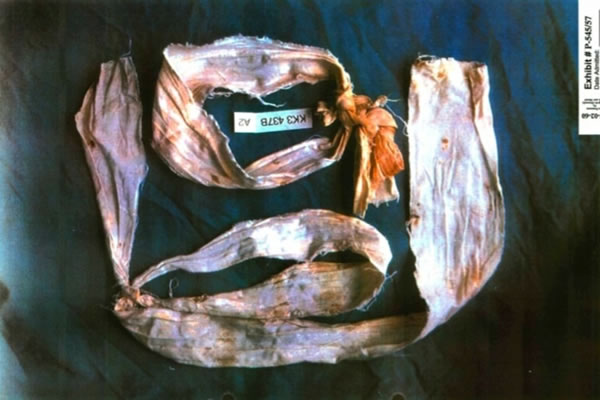Home
BLINDFOLDS TELL A TALE
Dutch textile expert Susan Maljaars analyzed pieces of fabric found in the Srebrenica mass graves. The fabric was used to blindfold and tie the prisoners who were later executed. The prosecution called Maljaars as its case continues at the trial of Ratko Mladic
 Pieces of binding textil from Srebrenica mass graves
Pieces of binding textil from Srebrenica mass graves Dutch chemist Susan Maljaars testified today for the first time about a report she wrote in February 2000, in which she outlined the results of the analysis of about 400 textile samples. The fabric was used to blindfold and tie the hands of the victims who were recovered from the mass graves in Srebrenica.
Jean-Rene Ruez, head of the team that investigated the crimes that occurred after the fall of Srebrenica, and Dean Manning, the team coordinator, handed the textile samples to the Dutch Forensic Institute. Maljaars’s task was to identify the blindfolds and ties made of the same fabric. The investigators used codes to mark each piece of fabric and each code indicated the time and place of recovery.
The samples were first analyzed macroscopically. Then, when similarities were established, the samples were examined under a microscope and tests were run to confirm the composition and special features of the textile. According to the report of the Dutch chemist, 16 pieces of fabric were analyzed in detail and matched: she was able to confirm that the pieces of fabric used to blindfold and tie the hands of the victims, recovered from different graves, were in fact identical.
In her analysis, the Dutch forensic expert showed that the bodies from the primary grave, where the victims executed at that location were initially buried, were transferred to several secondary graves. The pieces of the same fabric were thus found in two or more locations.
In the cross-examination, the defense put it to the witness that the analysis conducted by the Dutch Forensic Institute was not reliable because the sample was too small. The defense counsel noted that only 16 of the extant 400 samples were investigated in detail. Also, the results were then checked by the internal control. The data about the time and place of recovery marked on the samples by the OTP investigators were not verified, the defense counsel argued. Susan Maljaars defended the findings in her report.
After the Dutch chemist completed her testimony, the prosecution called retired VRS general Ljubomir Obradovic. This is the third time Obradovic is testifying as a prosecution witness. In 2007, he testified in the defense of his former superior in the VRS Main Staff, Radivoje Miletic. Obradovic’s testimony at the trial of Zdravko Tolimir, Mladic’s former assistant for intelligence and security, was admitted into evidence in the case against Ratko Mladic. The prosecutor read out the summary of Obradovic’s statement in court.
In the summer of 1995, Obradovic was the chief of the Operations and Training Administration in the VRS Main Staff. In his evidence, Obradovic described in detail the structure and the functioning of the VRS Main Staff. He described how the directives from the ‘high-ranking commands’ of the RS armed forces were prepared and written. In his testimony, Obradovic also explained who and how controlled the movement of humanitarian convoys heading for the enclaves that were nominally protected by the UN. As the hearing drew to a close, Mladic’s defense counsel began cross-examining Ljubomir Obradovic.
Linked Reports
- Case : Mladic
- 2013-07-15 EVIDENCE FROM MASS GRAVES
- 2013-07-10 AUSTRALIAN POLICE OFFICER IN SREBRENICA’S KILLING FIELDS
- 2013-07-09 NEW FIGURES FOR SREBRENICA VICTIMS
- 2013-07-18 SREBRENICA SYNDROME
- 2013-07-19 BLINDFOLDS AND TIES FROM MASS GRAVES
- 2013-07-22 BULLET CASINGS FROM SREBRENICA EXECUTION SITES ANALYZED
